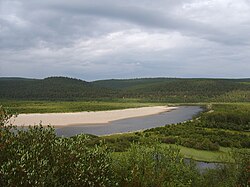Finnmarksvidda (Northern Sami: Finnmárkkoduottar; English: Finnmark plateau/highland) is Norway's largest plateau, with an area greater than 22,000 square kilometres (8,500 sq mi).[1] The plateau lies about 300 to 500 metres (980 to 1,640 ft) above sea level. Approximately 36% of Finnmark lies on the Finnmarksvidda.
Finnmarksvidda
Finnmárkkoduottar (Northern Sami) | |
|---|---|
 The lowest elevations can be found in the eastern part of Finnmarksvidda, near Karasjok and Tana. River valleys in the area are only 100–250 m (300–800 ft) above sea level. | |
 Interactive map of the lake | |
| Coordinates: 69°19′N 23°49′E / 69.317°N 23.817°E | |
| Location | Finnmark, Norway |
| Native name | Finnmárkkoduottar (Northern Sami) |
| Area | |
| • Total | 22,000 km2 (8,500 sq mi) |
| Elevation | 300 to 500 m (980 to 1,640 ft) |
Geography
editFrom Alta Municipality in the west to the Varanger Peninsula in the east it stretches for approximately 300 kilometres (190 mi), being at least that wide from north to south, extending into Finland. The southeastern part of the plateau is protected by the Anárjohka National Park. The 1,409 square kilometres (544 sq mi) park opened in 1976.[2]
Some circular lakes in Finnmarksvidda may be remnants of collapsed pingos that developed during cold periods of the last deglaciation.[3]
Fauna and flora
editThe plateau includes extensive birch woods, pine barrens, bogs, and glacially formed lakes. Finnmarksvidda is situated north of the Arctic Circle and is best known as the land of the once nomadic Sami people and their reindeer herds. Their shelters in the tundra are still used in the winter time.
Climate
editFinnmarksvidda, located in the interior of the county has a subarctic climate with the coldest winter temperatures in Norway: the coldest temperature ever recorded was −51.4 °C (−60.5 °F) in Karasjok on 1 January 1886. The climate of Kautokeino (307 m) represents the climate of the plateau.
Šihččajávri, 382m, is a weather station by the lake of the same name. It is situated high on the plateau and far inland, approximately 13 km (8 mi) from the E45 border crossing with Norway and Finland.[4]
| Climate data for Šihččajávri 1991−2020 (382m) | |||||||||||||
|---|---|---|---|---|---|---|---|---|---|---|---|---|---|
| Month | Jan | Feb | Mar | Apr | May | Jun | Jul | Aug | Sep | Oct | Nov | Dec | Year |
| Mean daily maximum °C (°F) | −8.9 (16.0) |
−8.9 (16.0) |
−4.7 (23.5) |
0.7 (33.3) |
6.6 (43.9) |
13.8 (56.8) |
17.4 (63.3) |
15.0 (59.0) |
9.3 (48.7) |
1.1 (34.0) |
−4.5 (23.9) |
−6.9 (19.6) |
2.6 (36.7) |
| Daily mean °C (°F) | −13.2 (8.2) |
−13.2 (8.2) |
−9.5 (14.9) |
−3.9 (25.0) |
2.5 (36.5) |
9.1 (48.4) |
12.8 (55.0) |
10.7 (51.3) |
5.6 (42.1) |
−1.6 (29.1) |
−7.9 (17.8) |
−10.8 (12.6) |
−1.6 (29.1) |
| Mean daily minimum °C (°F) | −18.9 (−2.0) |
−18.9 (−2.0) |
−15.3 (4.5) |
−9.0 (15.8) |
−1.7 (28.9) |
4.6 (40.3) |
8.2 (46.8) |
6.1 (43.0) |
1.8 (35.2) |
−5.0 (23.0) |
−12.4 (9.7) |
−16.3 (2.7) |
−6.3 (20.7) |
| Average precipitation mm (inches) | 28.5 (1.12) |
26.2 (1.03) |
22.1 (0.87) |
23.5 (0.93) |
38.9 (1.53) |
73.7 (2.90) |
91.6 (3.61) |
92.2 (3.63) |
61.2 (2.41) |
50.4 (1.98) |
37.4 (1.47) |
31.2 (1.23) |
576.9 (22.71) |
| Average precipitation days (≥ 1.0 mm) | 7 | 7 | 6 | 6 | 8 | 10 | 12 | 11 | 10 | 9 | 8 | 8 | 102 |
| Source: WMO[5] | |||||||||||||
References
edit- ^ "About Finnmark". Turistforeningen. Archived from the original on 2010-11-24. Retrieved 2010-04-10.
- ^ Ryvarden, Leif (2007). Stabbursdalen, Øvre Pasvik og Øvre Anárjohka. Norges nasjonalparker (in Norwegian). Vol. 3. Gyldendal. ISBN 9788205376380.
- ^ Svensson, Harald (1976). "Pingo problems in the Scandinavian countries". Biuletyn Peryglacjalny. 26: 33–40.
- ^ "Stasjonsinformasjon" (in Norwegian and English). Norwegian Meteorological Institute. Retrieved 29 April 2024.
- ^ "SIHCCAJAVRI Climate Normals 1991-2020". World Meteorological Organization. Retrieved April 29, 2024.